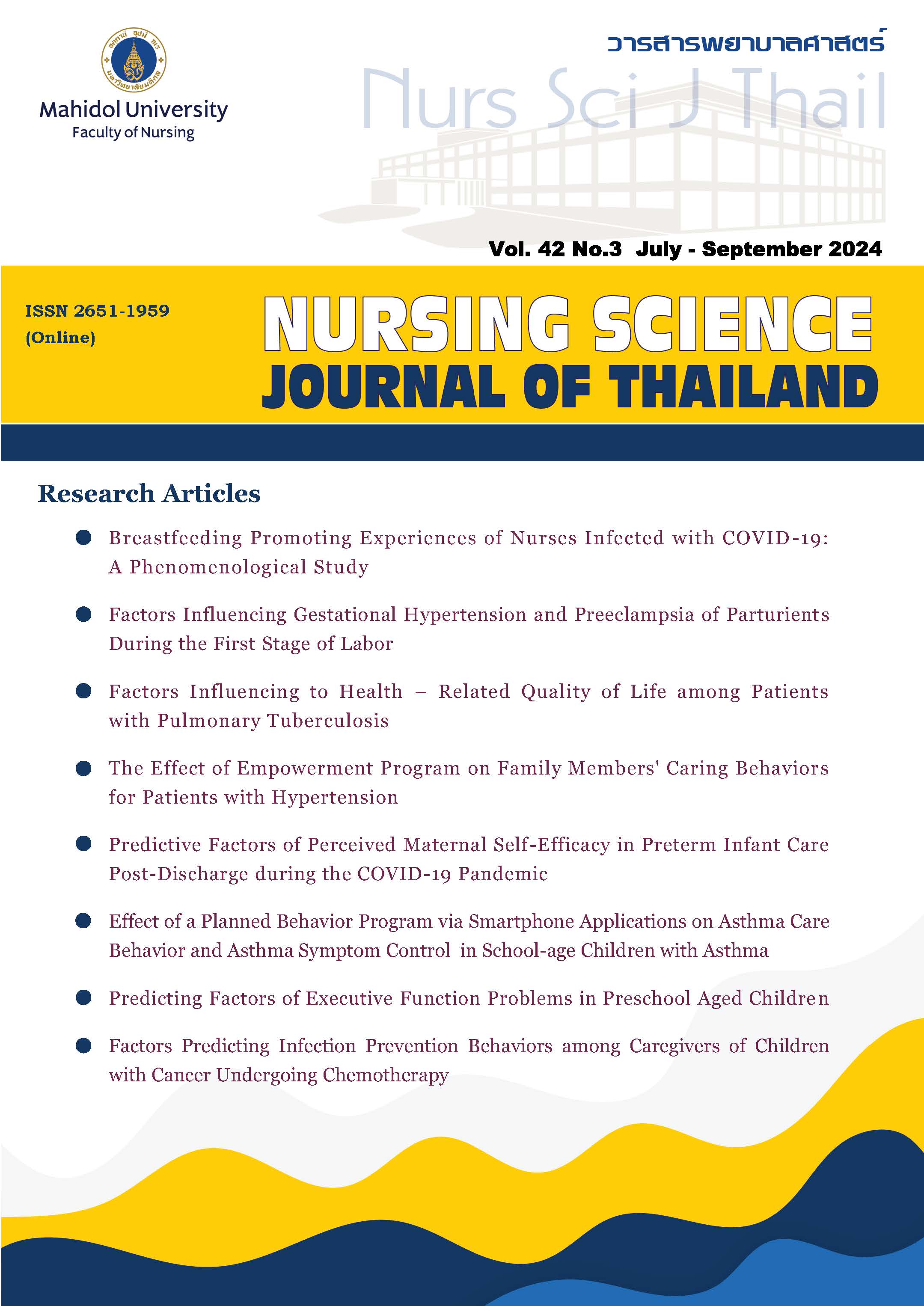ปัจจัยที่มีอิทธิพลต่อความดันโลหิตสูงเนื่องจากการตั้งครรภ์และภาวะครรภ์เป็นพิษของผู้คลอดในระยะที่ 1 ของการคลอด
Main Article Content
บทคัดย่อ
วัตถุประสงค์: เพื่อศึกษาอำนาจการทำนายของอายุ ดัชนีมวลกายก่อนตั้งครรภ์ ความวิตกกังวลในระยะคลอด และความรุนแรงที่เกิดจากคู่สมรสต่อความดันโลหิตสูงเนื่องจากการตั้งครรภ์และภาวะครรภ์เป็นพิษของผู้คลอดในระยะที่ 1 ของการคลอด
รูปแบบการวิจัย: การศึกษาจากผลไปหาเหตุแบบกลุ่มศึกษาและกลุ่มเปรียบเทียบ
วิธีดำเนินการวิจัย: กลุ่มตัวอย่างเป็นมารดาหลังคลอดจำนวน 195 ราย ที่ผ่านการคลอดปกติและคลอดด้วยวิธีสูติศาสตร์หัตถการอย่างน้อย 24 ชั่วโมง จากโรงพยาบาลตติยภูมิแห่งหนึ่งในกรุงเทพมหานคร กลุ่มตัวอย่างทั้งหมดแบ่งเป็น 2 กลุ่ม คือ กลุ่มศึกษาจำนวน 65 ราย เป็นกลุ่มที่ได้รับการวินิจฉัยว่ามีความดันโลหิตสูงเนื่องจากการตั้งครรภ์และภาวะครรภ์เป็นพิษในระยะที่ 1 ของการคลอด และกลุ่มเปรียบเทียบจำนวน 130 ราย เป็นกลุ่มที่ไม่มีความดันโลหิตสูงในระยะที่ 1 ของการคลอด เก็บรวบรวมข้อมูลโดยใช้แบบบันทึกข้อมูลส่วนบุคคล แบบบันทึกข้อมูลทางสูติกรรม แบบสอบถามความวิตกกังวลในระยะคลอด และแบบคัดกรองความรุนแรง ตามลำดับ วิเคราะห์ข้อมูลด้วยสถิติเชิงพรรณนา สถิติไคสแควร์ และสถิติถดถอยโลจิสติกเชิงพหุ
ผลการวิจัย: อายุ ดัชนีมวลกายก่อนตั้งครรภ์ ความวิตกกังวลในระยะคลอด และความรุนแรงที่เกิดจากคู่สมรส สามารถร่วมกันอธิบายความแปรปรวนของความดันโลหิตสูงเนื่องจากการตั้งครรภ์และภาวะครรภ์เป็นพิษของผู้คลอดในระยะที่ 1 ของการคลอดได้ร้อยละ 36 (R2 = .36) และมีความแม่นยำในการทำนายได้ถูกต้องร้อยละ 76.9 (overall percentage = 76.9) ปัจจัยที่สามารถทำนายได้อย่างมีนัยสำคัญทางสถิติ คือ ความวิตกกังวลในระยะคลอด (OR = 6.83, 95%CI = 3.10, 15.05) ดัชนีมวลกายก่อนตั้งครรภ์ ซึ่งได้แก่ ภาวะอ้วน (OR = 5.73, 95%CI = 2.27, 14.46) และน้ำหนักเกินเกณฑ์ (OR = 3.29, 95%CI = 1.39, 7.80) และความรุนแรงที่เกิดจากคู่สมรส (OR = 2.92, 95%CI = 1.27, 6.70) ตามลำดับ
สรุปและข้อเสนอแนะ: ความวิตกกังวลในระยะคลอด ดัชนีมวลกายก่อนตั้งครรภ์ และความรุนแรงที่เกิดจากคู่สมรสมีผลต่อการเกิดความดันโลหิตสูงเนื่องจากการตั้งครรภ์และภาวะครรภ์เป็นพิษในระยะที่ 1 ของการคลอด ดังนั้น พยาบาลผดุงครรภ์ควรประเมินปัจจัยเสี่ยงดังกล่าวและพัฒนารูปแบบการพยาบาลผู้คลอดเพื่อป้องกันการเกิดความดันโลหิตสูงเนื่องจากการตั้งครรภ์และภาวะครรภ์เป็นพิษในระยะที่ 1 ของการคลอด
Article Details

อนุญาตภายใต้เงื่อนไข Creative Commons Attribution-NonCommercial-NoDerivatives 4.0 International License.
ลิขสิทธิ์: วารสารพยาบาลศาสตร์เป็นเจ้าของลิขสิทธิ์ในการเผยแพร่ผลงานที่ตีพิมพ์ ห้ามผู้ใดนำบทความที่ได้รับการตีพิมพ์ในวารสารพยาบาลศาสตร์ไปเผยแพร่ในลักษณะต่างๆ ดังต่อไปนี้ การส่งบทความไปตีพิมพ์เผยแพร่ที่อื่น การนำบทความเผยแพร่ออนไลน์ การถ่ายเอกสารบทความเพื่อกิจกรรมที่ไม่ใช่การเรียนการสอน ยกเว้นเสียแต่ได้รับอนุญาตจากวารสารพยาบาลศาสตร์

Disclaimer: เนื้อหาบทความหรือข้อคิดเห็นใดๆ ในวารสารพยาบาลศาสตร์ ถือเป็นความรับผิดชอบของผู้เขียน กองบรรณาธิการไม่จำเป็นต้องเห็นด้วยและไม่มีส่วนรับผิดชอบแต่อย่างใด
เอกสารอ้างอิง
The Royal Thai College of Obstetricians and Gynecologists. Era of the next normal RTCOG annual meeting 2021. Bangkok: The Royal Thai College of Obstetricians and Gynecologists; 2021. 324 p. (in Thai).
Gestational hypertension and preeclampsia: ACOG practice bulletin, Number 222. Obstet Gynecol. 2020;135(6):e237-e60. doi: 10.1097/AOG.0000000000003891.
Chuchotirot M, Sarnsuwan S, Wonglamai P, Khajonjit P, Watsing A, Wuttiviboonchok W, et al. Obstetrics and gynecologic registry annual statistical report 2020. Bangkok: Department of Obstetrics and Gynecology, Faculty of Medicine Siriraj Hospital; 2022. 174 p. (in Thai).
Ushida T, Kotani T, Imai K, Nakano-Kobayashi T, Iitani Y, Nakamura N, et al. Prevalence and risk factors of labor-onset hypertension: a multicenter study in Japan. Pregnancy Hypertens. 2021;26:48-53. doi: 10.1016/j.preghy.2021.08.118.
Lugobe HM, Muhindo R, Kayondo M, Wilkinson I, Agaba DC, McEniery C, et al. Risks of adverse perinatal and maternal outcomes among women with hypertensive disorders of pregnancy in southwestern Uganda. PLoS One. 2020;15(10):e0241207. doi: 10.1371/journal.pone.0241207.
Cunningham FG, Leveno KJ, Bloom SL, Dashe JS, Hoffman BL, Casey BM, et al. Williams Obstetrics. 26th ed. New York: McGraw-Hill; 2022. 1323 p.
Sysavath S, Rujiraprasert N. Risk factors for hypertensive disorders in pregnancy in Lao People’s Democratic Republic. Journal of Nursing Science and Health. 2020;43(2):45-54. (in Thai).
Tongmuangtunyatep K, Dekyong E, Yodwong A, Thongsukdee T, Sanongkun P. Factors predicting preeclampsia among pregnant women in Sawanpracharak Hospital. Songklanagarind Journal of Nursing. 2022;42(1):11-22. (in Thai).
Engel GL. The need for a new medical model: a challenge for biomedicine. Science. 1977;196(4286):129-36. doi: 10.1126/science.847460.
Qu H, Khalil RA. Vascular mechanisms and molecular targets in hypertensive pregnancy and preeclampsia. Am J Physiol Heart Circ Physiol. 2020;319(3):H661-81. doi: 10.1152/ajpheart.00202.2020.
Sheen J-J, Huang Y, Andrikopoulou M, Wright JD, Goffman D, D'Alton ME, et al. Maternal age and preeclampsia outcomes during delivery hospitalizations. Am J Perinatol. 2020;37(1):44-52. doi: 10.1055/s-0039-1694794.
Li L, Chen Y, Lin Z, Lin W, Liu Y, Ou W, et al. Association of pre-pregnancy body mass index with adverse pregnancy outcome among first-time mothers. PeerJ. 020;8:e10123 doi: 10.7717/peerj.10123.
WHO Expert Consultation. Appropriate body-mass index for Asian populations and its implications for policy and intervention strategies. Lancet. 2004;363(9403):157-63. doi: 10.1016/S0140-6736(03)15268-3.
Nath A, Sheeba B, Sisira R, Metgud CS. Prevalence of hypertension in pregnancy and its associated factors among women attending antenatal clinics in Bengaluru. J Family Med Prim Care. 2021;10(4):1621-27. doi: 10.4103/jfmpc.jfmpc_1520_20.
Raina J, El-Messidi A, Badeghiesh A, Tulandi T, Nguyen T-V, Suarthana E. Pregnancy hypertension and its association with maternal anxiety and mood disorders: a population-based study of 9 million pregnancies. J Affect Disord. 2021;281:533-38. doi: 10.1016/j.jad.2020.10.058.
Auger N, Low N, Lee GE, Ayoub A, Luu TM. Pregnancy outcomes of women hospitalized for physical assault, sexual assault, and intimate partner violence. J Interpers Violence. 2022;37(13-14):NP11135. doi: 10.1177/0886260520985496.
Yasmin S, Shafqat T, Sabir S, Syed W, Liaqat N. Domestic violence as a risk factor for hypertensive disorders of pregnancy. Medical Forum Monthly. 2021;32(3):64-9.
Greely JT, Dongarwar D, Crear L, Adeyeye M, Reyna-Carrillo A, Salihu HM. Violence against pregnant women and adverse maternal/fetal outcomes in the United States: racial/ethnic disparities. Women Health. 2022;62(6):513-21. doi: 10.1080/03630242.2022.2074610.
Baosoung C. The effect of planned instruction and touching on anxiety level and coping behavior during labor [master’s thesis]. Bangkok: Mahidol University; 1983. 155 p. (in Thai).
McFarlane J, Parker B, Soeken K, Bullock L. Assessing for abuse during pregnancy: severity and frequency of injuries and associated entry into prenatal care. JAMA. 1992;267(23):3176-78. doi: 10.1001/jama.267.23.3176.
Thananowan N. Intimate partner violence (IPV) among Thai pregnant women: the
correlation of violence with maternal characteristics, health practices during pregnancy, and maternal health [dissertation]. Madison, WI: University of Wisconsin-Madison; 2004. 164 p.
Shynlova O, Nadeem L, Zhang J, Dunk C, Lye S. Myometrial activation: novel concepts underlying labor. Placenta. 2020;92:28-36. doi: 10.1016/j.placenta.2020.02.005.
Chen Y, Wan K, Gong Y, Zhang X, Liang Y, Wang X, et al. Assessing the relationship between pregravid body mass index and risk of adverse maternal pregnancy and neonatal outcomes: prospective data in Southwest China. Sci Rep. 2021;11(1):7591. doi: 10.1038/s41598-021-87135-9.
Somprasit C, Tanprasertkul C, Rattanasiri T, Saksiriwutth P, Wongkum J, Kovavisarach E, et al. High pre-pregnancy body mass index and the risk of poor obstetrics outcomes among Asian women using BMI criteria for Asians by World Health Organization Western Pacific Region (WPRO): a large cohort study. J Med Assoc Thai. 2015;98 Suppl 2:S101-7.
Shay M, MacKinnon A, Metcalfe A, Giesbrecht G, Campbell T, Nerenberg K, et al. Depressed mood and anxiety as risk factors for hypertensive disorders of pregnancy: a systematic review and meta-analysis. Psychol Med. 2020;50(13):2128-40. doi: 10.1017/S0033291720003062.
Thompson NN, Mumuni K, Oppong SA, Sefogah PE, Nuamah MA, Nkyekyer K. Effect of intimate partner violence in pregnancy on maternal and perinatal outcomes at the Korle Bu teaching hospital, Ghana: an observational cross sectional study. Int J Gynaecol Obstet. 2023;160(1):297-305. doi: 10.1002/ijgo.14375.


